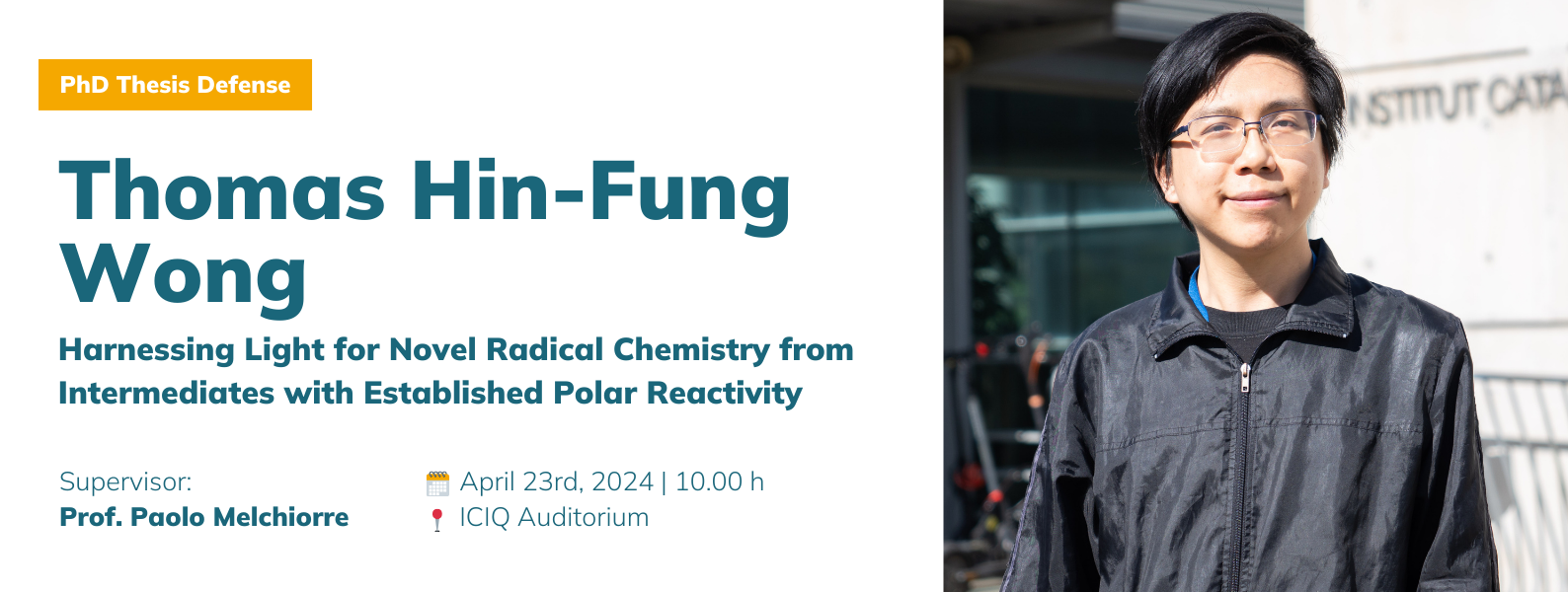 23/04/2024
23/04/2024
 10:00
10:00
 ICIQ Auditorium
ICIQ Auditorium
- Lecturer: Thomas Hin-Fung Wong
- Supervisors: Prof. Paolo Melchiorre
Harnessing Light for Novel Radical Chemistry from Intermediates with Established Polar Reactivity
Organocatalysis is recognized for its power to activate substrates through generic modes of reactivity. While the intermediate formed upon activation of the substrate by the chiral catalyst can participate in many reaction types with consistently high stereoselectivity, the intrinsic limit of this approach is that it only allows the design of mechanistically related processes. These limitations were recently removed with the introduction of catalytic amount of colored metal complexes (photoredox catalysts) as intermediaries between visible light and colorless substrates. The urge to uncover novel reactivity has provided a force for innovation in enantioselective radical chemistry and photoredox catalysis. Along these lines, the research work described in this presentation has demonstrated how intermediates with established polar chemistry can be repurposed for radical reactivity to solve otherwise difficult synthetic problems. Through the judicious selection of photocatalysts and radical precursors, these classical intermediates could be involved in novel radical chemistry. This opened up new opportunities for selective C-C and C-S bond formations, yielding diverse scaffolds with potential bioactivity.
Iminium ions exhibit a rich chemistry in the polar domain. It was demonstrated that iminium ion catalysis is also effective in radical pathways, ensuring the interception of nucleophilic primary radicals for conjugate addition with high stereocontrol. Employing a strongly oxidizing acridinium organic photocatalyst, the non-stabilized primary radicals were generated upon oxidative ring opening of cyclobutanols. The chiral iminium intermediates were effective in overcoming racemic background processes while trapping short-lived open-shell species, ensuring good enantioselectivity in 1,7-dicarbonyl scaffold formation. The resulting products offered a straightforward access to analogs of natural products and pharmaceuticals, introducing new stereocenters through simple transformations.
To further expand the chemistry, a radical umpolung strategy for chiral iminium ions was developed. Leveraging their electrophilicity, the SET reduction of chiral iminium ions switched the electrophilic β-position to nucleophilic within the resultant chiral 5π-electron radical. This polarity-inversion permitted the cross-electrophile coupling between two unsaturated carbonyl compounds to take place, affording chiral 1,6-dicarbonyl compounds as a single regioisomer with excellent enantioselectivity. Building on this photoredox organocatalytic approach, the first example of asymmetric conjugate cynation of enals was also disclosed. The preparation of β-cyanoaldehyde with good enantioselectivity and exclusive chemoselectivity permitted a short synthetic route to unnatural chiral amino acids.
Isothiouronium ions is another class of polar intermediate that were utilized for metal and thiol-free synthesis of thioethers. An extension to its chemistry through a radical-polar sequence was reported. Using a strongly reducing thioxindole organic photocatalyst, strong C(sp2)-Cl bond can be cleaved to form aryl radicals, which in turn engage in aryl C-S bond formation with thiourea. This resultant aryl isothiouronium intermediate can then intersect with established ionic deoxythiolation pathways, reacting with alkyl alcohols in a single cascade to deliver aryl alkyl thioether. Benefiting from the abundance of commercial substrates and remarkable tolerance for functional groups, our protocol allowed the preparation of diverse thioether products that were previously inaccessible and facilitated late-stage modifications of biorelevant compounds.

If you would like to follow the thesis defense online, please, register here
Other events

Let's create a brighter future
Join our team to work with renowned researchers, tackle groundbreaking
projects and contribute to meaningful scientific advancements



















